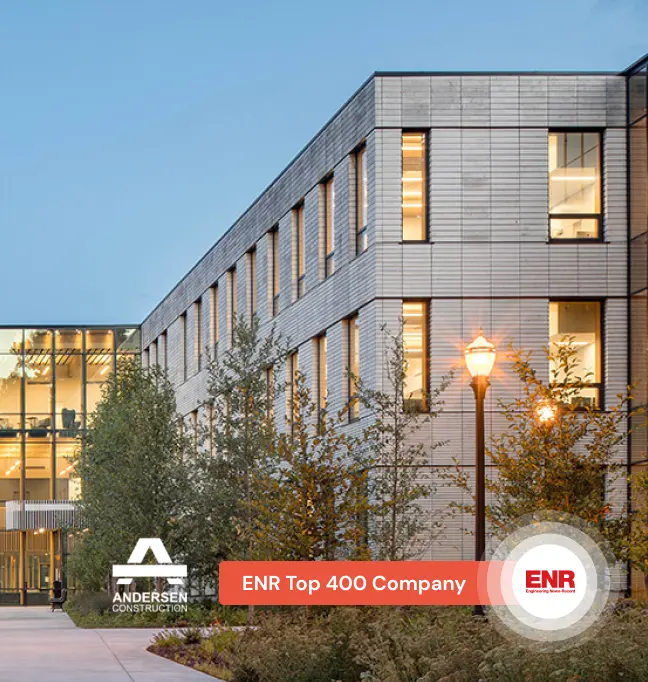Founded in 1950 by Andy Andersen in Portland, Oregon, Andersen Construction now has offices throughout the Pacific Northwest including Portland, Seattle, Eugene, and Boise. Today, the regional builder’s specialties include healthcare, education, and multi-family housing. However, they have done every type of horizontal construction.
Andersen, which is at the forefront of highly collaborative management approaches, is focused on doing what they say they are going to do. In the end, Andersen’s goal is simple: build projects that their client and the entire design and construction team are proud of, to continue their reputation of being the “Builder of Choice.”
THE CHALLENGE
As businesses grow, workforce planning becomes more complex. This is particularly true in the construction industry where collaboration with other companies is essential and time is of the essence.
As the number of employees at Andersen has expanded, the company’s systems were not keeping up. Time was not being utilized effectively, particularly when it came to workforce planning.
“When our staff in the field grew to over 100 in a single region, our old tool of Microsoft Excel spreadsheets was no longer effective,” says Mark Horton, Operations Manager in Andersen’s Oregon location.

“Resource management was cumbersome and a time suck.”
Mark Horton, Operations Manager – Oregon at Andersen Construction
It was clear to Horton and his colleagues that Andersen needed a new workforce management tool.
THE SOLUTION
As the Andersen team searched for a new workforce management system, their primary criterion was efficiency. “Efficiency was going to win the day,” says Horton. They also wanted something that was intuitive and accurate.
Finally, Andersen wanted the new system to make it simpler to manage resources and make it easier to project needs. Horton says, “We wanted to make sure we know where our people are and be able to predict utilization.”
Ultimately, Andersen settled on Bridgit Bench. The workforce management system came recommended based on its level of support, engagement, and commitment to adapt and evolve over time.
While Horton has been pleased with the support from Bridgit and its product advancement, other aspects of the system have also stood out. “There’s a minimal learning curve when it comes to using Bridgit Bench,” says Horton.
And then there’s the efficiency of Bridgit Bench. “When we used to meet and do resource planning, half the meeting would be spent on getting the tool to work and making duplicate entries,” says Horton.
The ease of use and simple updates allow meetings to be more meaningful.
“Now, when we meet across all regions, the Ops Managers can use the time for its intended purpose – talking about and making high-level decisions.”
Mark Horton, Operations Manager – Oregon at Andersen Construction
Resource planning takes significantly less time because the workforce management tool is more efficient. Horton estimates that time spent on resource management for the Oregon office, which includes just under 200 people, previously took nine hours a week. Now, it takes just three hours a week.
Besides workforce management requiring less time, Andersen has enjoyed other benefits. In the past, Horton and the team were reluctant to give access to others who might accidentally manipulate the workforce plan.
Because there are various permission levels in Bridgit Bench, different teams can view what matters for them. With Bridgit Bench, sharing and granting visibility is happening more regularly at Andersen which makes the process more collaborative.
“I like the view only permissions because it can be shared with a larger audience and they can see what is applicable to them,” says Horton. “It’s also helpful to be able to filter exactly what you want and mine out data.”
The workforce management tool’s accessibility and portability are also appreciated. Horton notes he enjoys being able to log in from wherever he is and being able to get real-time information.
That portability is particularly useful these days since the COVID-19 pandemic hit forcing many to work from home. Like every business, Andersen has had to adjust its resources based on the virus. “It’s a brand-new world,” says Horton. “We’re putting company policies in place based on government guidelines, communicating regularly with our teams, and ensuring we comply with mandates that ensure we keep our staff and trade partners safe.”
Although Oregon has not shut down construction and manpower needs have remained static, Andersen’s operations in Seattle have been impacted as some projects were shut down or paused. This has led to a surplus of available resources in that area. Of course, this is a fluid situation and changes are happening regularly. Having Bridgit Bench lets Andersen continue to manage their workforce planning remotely during these difficult times.
As Andersen Construction continues to build projects that make clients and their teams proud, they have a workforce management tool to help them meet that goal. The added efficiency makes this proud family-owned operation able to look to the future.

